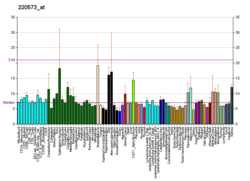KLK14
Kallikrein-14 is a protein that in humans is encoded by the KLK14 gene.[5][6][7]
Kallikreins are a subgroup of serine proteases having diverse physiological functions. Growing evidence suggests that many kallikreins are implicated in carcinogenesis and some have potential as novel cancer and other disease biomarkers. This gene is one of the fifteen kallikrein subfamily members located in a cluster on chromosome 19. An additional transcript variant has been described but its full length nature has not been determined.[7]
References
- 1 2 3 GRCh38: Ensembl release 89: ENSG00000129437 - Ensembl, May 2017
- 1 2 3 GRCm38: Ensembl release 89: ENSMUSG00000044737 - Ensembl, May 2017
- ↑ "Human PubMed Reference:".
- ↑ "Mouse PubMed Reference:".
- ↑ Lundwall A, Band V, Blaber M, Clements JA, Courty Y, Diamandis EP, Fritz H, Lilja H, Malm J, Maltais LJ, Olsson AY, Petraki C, Scorilas A, Sotiropoulou G, Stenman UH, Stephan C, Talieri M, Yousef GM (Jun 2006). "A comprehensive nomenclature for serine proteases with homology to tissue kallikreins". Biol Chem. 387 (6): 637–41. doi:10.1515/BC.2006.082. PMID 16800724.
- ↑ Diamandis, Eleftherios P.; Deperthes, David; Lundwall, Åke (Jun 2006). "Proceedings of the 1st International Symposium on Kallikreins, Lausanne, Switzerland, September 1-3 , 2005". Biol Chem. 387 (6): 635–824. doi:10.1515/BC.2006.081. PMID 16800723.
- 1 2 "Entrez Gene: KLK14 kallikrein-related peptidase 14".
Further reading
- Harvey TJ, Hooper JD, Myers SA, et al. (2001). "Tissue-specific expression patterns and fine mapping of the human kallikrein (KLK) locus on proximal 19q13.4". J. Biol. Chem. 275 (48): 37397–406. doi:10.1074/jbc.M004525200. PMID 10969073.
- Yousef GM, Magklara A, Chang A, et al. (2001). "Cloning of a new member of the human kallikrein gene family, KLK14, which is down-regulated in different malignancies". Cancer Res. 61 (8): 3425–31. PMID 11309303.
- Hooper JD, Bui LT, Rae FK, et al. (2001). "Identification and characterization of KLK14, a novel kallikrein serine protease gene located on human chromosome 19q13.4 and expressed in prostate and skeletal muscle". Genomics. 73 (1): 117–22. doi:10.1006/geno.2000.6490. PMID 11352573.
- Yousef GM, Borgoño CA, Scorilas A, et al. (2003). "Quantitative analysis of human kallikrein gene 14 expression in breast tumours indicates association with poor prognosis". Br. J. Cancer. 87 (11): 1287–93. doi:10.1038/sj.bjc.6600623. PMC 2408908. PMID 12439719.
- Strausberg RL, Feingold EA, Grouse LH, et al. (2003). "Generation and initial analysis of more than 15,000 full-length human and mouse cDNA sequences". Proc. Natl. Acad. Sci. U.S.A. 99 (26): 16899–903. doi:10.1073/pnas.242603899. PMC 139241. PMID 12477932.
- Yousef GM, Stephan C, Scorilas A, et al. (2003). "Differential expression of the human kallikrein gene 14 (KLK14) in normal and cancerous prostatic tissues". Prostate. 56 (4): 287–92. doi:10.1002/pros.10263. PMID 12858357.
- Grimwood J, Gordon LA, Olsen A, et al. (2004). "The DNA sequence and biology of human chromosome 19". Nature. 428 (6982): 529–35. doi:10.1038/nature02399. PMID 15057824.
- Brattsand M, Stefansson K, Lundh C, et al. (2005). "A proteolytic cascade of kallikreins in the stratum corneum". J. Invest. Dermatol. 124 (1): 198–203. doi:10.1111/j.0022-202X.2004.23547.x. PMID 15654974.
- Felber LM, Borgoño CA, Cloutier SM, et al. (2005). "Enzymatic profiling of human kallikrein 14 using phage-display substrate technology". Biol. Chem. 386 (3): 291–8. doi:10.1515/BC.2005.035. PMID 15843175.
- Fritzsche F, Gansukh T, Borgoño CA, et al. (2006). "Expression of human Kallikrein 14 (KLK14) in breast cancer is associated with higher tumour grades and positive nodal status". Br. J. Cancer. 94 (4): 540–7. doi:10.1038/sj.bjc.6602956. PMC 2361186. PMID 16434994.
- Stefansson K, Brattsand M, Ny A, et al. (2006). "Kallikrein-related peptidase 14 may be a major contributor to trypsin-like proteolytic activity in human stratum corneum". Biol. Chem. 387 (6): 761–8. doi:10.1515/BC.2006.095. PMID 16800737.
- Borgoño CA, Michael IP, Shaw JL, et al. (2007). "Expression and functional characterization of the cancer-related serine protease, human tissue kallikrein 14". J. Biol. Chem. 282 (4): 2405–22. doi:10.1074/jbc.M608348200. PMID 17110383.
- Borgoño CA, Michael IP, Komatsu N, et al. (2007). "A potential role for multiple tissue kallikrein serine proteases in epidermal desquamation". J. Biol. Chem. 282 (6): 3640–52. doi:10.1074/jbc.M607567200. PMID 17158887.
External links
This article is issued from
Wikipedia.
The text is licensed under Creative Commons - Attribution - Sharealike.
Additional terms may apply for the media files.




